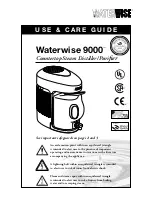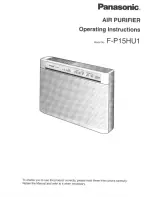
5 Application guidelines
Installer reference guide
14
ERLQ004~008CA + 08S18CB
Daikin Altherma – Low temperature split
4P401676-1D – 2018.07
▪ The consumed energy is calculated internally based on:
▪ The actual power input of the outdoor unit
▪ The set capacity of the backup heater
▪ The voltage
▪ Setup and configuration: To get accurate energy data, measure
the capacity (resistance measurement) and set the capacity via
the user interface for the backup heater (step 1).
Measuring the consumed energy
▪ Applicable for all models.
▪ Preferred method because of higher accuracy.
▪ Requires external power meters.
▪ Setup and configuration: When using electrical power meters, set
the number of pulses/kWh for each power meter via the user
interface. Consumed energy data for EHVZ16 model will only be
available if this setting is configured.
INFORMATION
When measuring the electrical power consumption, make
sure ALL power input of the system is covered by the
electrical power meters.
5.4.3
Normal kWh rate power supply
General rule
One power meter that covers the entire system is sufficient.
Setup
Connect the power meter to X5M/7 and X5M/8.
Power meter type
In case of…
Use a… power meter
▪ Single-phase outdoor unit
▪ Backup heater supplied from a
single-phase grid
Single-phase
Three-phase outdoor unit
Three-phase
Example
Single-phase power meter
Three-phase power meter
b
580
1 50
0
0
c
c
f
e
d
A
B
a
A
Outdoor unit
B
Indoor unit
a
Electrical cabinet (L
1
/N)
b
Power meter (L
1
/N)
c
Fuse (L
1
/N)
d
Outdoor unit (L
1
/N)
e
Indoor unit (L
1
/N)
f
Backup heater (L
1
/N)
b
580
1 50
0
0
g
f
e
A
B
c
d
a
A
Outdoor unit
B
Indoor unit
a
Electrical cabinet (L
1
/L
2
/L
3
/N)
b
Power meter (L
1
/L
2
/L
3
/N)
c
Fuse (L
1
/L
2
/L
3
/N)
d
Fuse (L
1
/N)
e
Outdoor unit (L
1
/L
2
/L
3
/N)
f
Indoor unit (L
1
/L
2
/L
3
/N)
g
Backup heater (L
1
/N)
Exception
▪ You can use a second power meter if:
▪ The power range of one meter is insufficient.
▪ The electrical meter cannot easily be installed in the electrical
cabinet.
▪ 230 V and 400 V three-phase grids are combined (very
uncommon), because of technical limitations of power meters.
▪ Connection and setup:
▪ Connect the second power meter to X5M/9 and X5M/10.
▪ In the software the power consumption data of both meters is
added so you do NOT have to set which meter covers which
power consumption. You only need to set the number of pulses
of each power meter.
▪ See
"5.4.4 Preferential kWh rate power supply" on page 14
for
an example with two power meters.
5.4.4
Preferential kWh rate power supply
General rule
▪ Power meter 1: Measures the outdoor unit.
▪ Power meter 2: Measures the rest (i.e. indoor unit and backup
heater).
Setup
▪ Connect power meter 1 to X5M/7 and X5M/8.
▪ Connect power meter 2 to X5M/9 and X5M/10.
Power meter types
▪ Power meter 1: Single- or three-phase power meter according to
the power supply of the outdoor unit.
▪ Power meter 2: Use a single-phase power meter.
5.5
Setting up the power consumption
control
▪ The power consumption control:
▪ Is only applicable for 08.
▪ Allows you to limit the power consumption of the entire system
(sum of outdoor unit, indoor unit and backup heater).
▪ Configuration: Set the power limitation level and how it has to
be achieved via the user interface.
▪ The power limitation level can be expressed as:
▪ Maximum running current (in A)
▪ Maximum power input (in kW)
▪ The power limitation level can be activated:
▪ Permanently
▪ By digital inputs
5.5.1
Permanent power limitation
Permanent power limitation is useful to assure a maximum power or
current input of the system. In some countries, legislation limits the
maximum power consumption for space heating and DHW
production.
P
i
t
DI
a
b















































